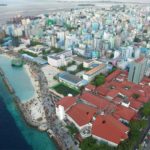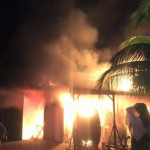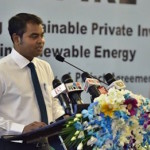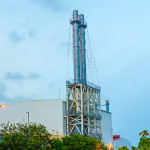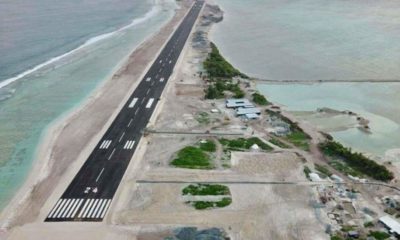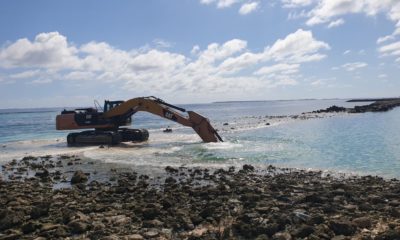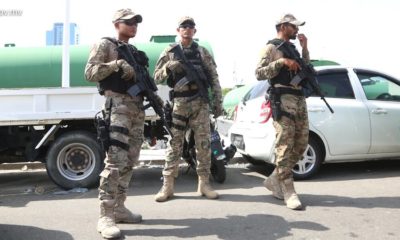The housing ministry on Sunday allocated land from the industrial village in Malé’s southwestern harbour for the State Electricity Company to build a new powerhouse.
Housing Minister Dr Mohamed Muiz told the press that the new powerhouse will be used to provide electricity from a separate grid to the industrial village after warehouses, workshops and the waste management centre are moved to the reclaimed area.
The powerhouse will also be used as a backup plant “when electricity goes out from time to time in Malé,” he said.
The 10,000 square feet plot was handed over to the state-owned utility company free of charge, he added.
Abdul Shakoor Solih, STELCO’s managing director, said at the handover ceremony that the company expects to generate at least six megawatts from the new multi-storey powerhouse.
“But perhaps in the next five years, it could increase to 10 or 12 megawatts. Even if we’re not able to generate that much immediately, that is how we are planning,” he said, adding that STELCO hopes to complete the powerhouse in one and a half years.
The handover came after the government faced widespread criticism about the lack of a backup electricity plan for Malé after a power outage last week left the capital without running water for three hours.
STELCO officials told state media that the outage was caused by the biggest technical problem the company faced in the past 12 years.
All the generators at the STELCO power plant shut down due to a fault with a switchgear set up to temporarily provide electricity to the Malé Water and Sewerage Company during the December 2014 water crisis, when a fire at the MWSC’s desalination plant left the capital’s 130,000 residents without running water for nine days.
Witnesses heard a loud bang coming from the MWSC building just before electricity went out last week.
STELCO Director Ibrahim Rauf explained that the problem was caused by a ground fault of 10,000 watts.
“We built our protection systems very well but when such a fault happens, because of the way it happens, those systems itself fails and it doesn’t protect them,” he said.
Energy Minister Thoriq Ibrahim told the state media that the long-term solution is the US$100 million STELCO fifth power project, which involves building a powerhouse in the capital’s suburb with the capacity of generating 50 megawatts of electricity for Malé, Hulhulé and Hulhumalé via the China-Maldives Friendship bridge.
On Monday, the finance ministry made an announcement seeking interested parties to build a power interconnection network via the 1.39km-long bridge.
Earlier this month, STELCO also made an announcement seeking interest parties to build a new 14-storey building on a vacant plot west of its main headquarters in Malé. Officials told local media that the new building will solve difficulties caused by the shortage of space in the 17-year-old STELCO building.
The March 5 power outage meanwhile revived debates about decentralisation, electricity subsidies, and the use of funds collected during the December 2014 water crisis.
The MWSC claimed that water supply resumed shortly after STELCO managed to restore power, but several households complained that water was not available on higher floors.
The water company insisted last week that services were fully restored but informed the public on Tuesday that water might not be available at high pressure for three hours after midnight as repair work would be underway on its water distribution pump.
After the power outage last week, the Maldivian Democratic Party meanwhile criticised the government’s “failure” to assure basic utility services.
The main opposition party blamed the disruptions on corrupt practices and the “extreme politicisation” of state-owned companies, alleging that technical staff have been replaced by political appointees whilst other employees are forced to join the ruling party and attend rallies.
The MDP also criticised the current administration’s policy of relocating 70 percent of the country’s scattered population to Hulhumalé, the reclaimed island near the capital that is under development as an urban centre.
“Since the Maldives is an island nation, the country can only be developed by developing all regions. If the entire population is moved to the Malé area and congested, people will have to face similar problems in the future,” the party said in a statement.
The MDP also called on the government to disclose how MVR107 million (US$6.9 million) raised for the Malé water crisis management fund was used.
The government meanwhile went on a media offensive in the wake of the power outage with Energy Minister Thoriq appearing on the state broadcaster and dismissing the MDP’s statement as lacking any “basis or fact” and accusing the party of misleading the public.
The government has appointed highly-trained and qualified staff to utility companies, he insisted, adding that work is underway to upgrade the Malé power grid.
Responding to criticism in a speech last week, President Abdulla Yameen accused the MDP government of neglecting to upgrade STELCO’s capacity during its three years in office.
He also defended the government’s decision to cut electricity subsidies as necessary to save funds from the government budget.
“So if a company providing electricity is being run on subsidies, think about how you can run development projects while giving subsidies for electricity, even though higher priority has to be given for subsidies for staple foods and medicine,” he was quoted as saying.


